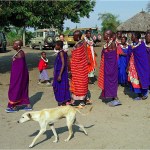inbreeding
Could be the title of the paper. Anyway, Genome-wide association mapping identifies multiple loci for a canine SLE-related disease complex:
...Incidences of specific diseases are elevated in different breeds, indicating that a few genetic risk factors might have accumulated through drift or selective breeding. In this study, a GWA study with 81 affected dogs (cases) and 57 controls from the Nova Scotia duck tolling retriever breed identified five loci associated with a canine systemic lupus erythematosus (SLE)-related disease complex that includes both antinuclear antibody (ANA)-positive…
The folks at PNAS have been biting their nails to the quick, anxiously awaiting the release of their groundbreaking news- Mutts are more genetically diverse than purebreds! The article had been under embargo until yesterday, forcing the researchers and journal editors to keep the valuable information under wraps. "I had a really hard time not telling my wife," admitted one of the journal editors, "I almost slipped up two times!"
As a precaution to prevent leaks to the media, the authors of the study have spent the last 10 days sequestered at an undisclosed hotel. Insider reports said they…
On November 1st, 1700, an entire dynasty of kings came to a crashing end with the death of Charles II of Spain. Charles had neither a pleasant life nor a successful reign. He was physically disabled, mentally retarded and disfigured. A large tongue made his speech difficult to understand, he was bald by the age of 35, and he died senile and wracked by epileptic seizures. He had two wives but being impotent, he had no children and thus, no heirs. Which is what happens after 16 generations of inbreeding.
Charles II was the final king of the Spanish Habsburg dynasty (see family tree), part of a…
The Hapsburgs are one of those royal families who are relatively well known, and in the minds of the public are to a great extent the emblems of the downsides of inbreeding. To painting to the left is of Charles II, king of Spain, the last of the Spanish Hapsburgs, and an imbecile whose premature death at the age of 39 ushered in a period of dynastic chaos which led to the War of Spanish Succession These conflicts between France and other European powers were one of those turning points in history, a sad capstone to the long reign of the Sun King, Louis the XIV. France's position as the…
Genetic Future points to a new paper which suggests that inbreeding is declining over time. Their methodology involved surveying different age cohorts and noting the decreased levels of homozygosity among the youth. Dienekes points out that the use of living people might simply be confounding inferred mating patterns with the fact that homozygous individuals have a higher life expectancy. The plausibility of these two hypotheses varies based on how much weight you put on the shifting of mating patterns. In Consanguinity, Inbreeding, and Genetic Drift in Italy the authors used Catholic…
If you read an older work like The History and Geography of Human Genes based on classical genetic markers Sardinia stands out on charts of genetic distance. This is probably due to the fact that Sardinia is an island and gene flow from surrounding regions is relatively limited due to the physical barriers. So the first settlers have an outsized genetic impact which is not diluted over time by intermarriage with surrounding populations. Additionally, because an island can be treated as an isolate, that reduces effective population and increases the power of random genetic drift, which will…
tags: evolution, beak and body size, Geospiza fortis, inbreeding, mating patterns, reproductive isolation, sexual imprinting
A family tree depicts the evolution of the 14 species of "Darwin's finches".
(The focus of this study, the Medium Ground Finch, Geospiza fortis, is denoted with a red dot).
[larger image].
I have always been fascinated by the process of speciation throughout my scientific career because speciation is the "engine" that generates biological diversity. But what are the evolutionary mechanisms that lead to speciation? We know that mate choice can be one important…
